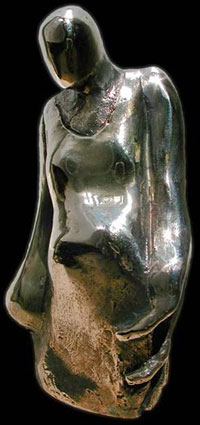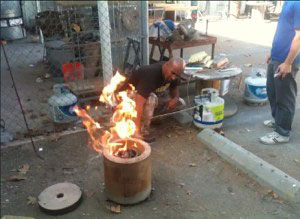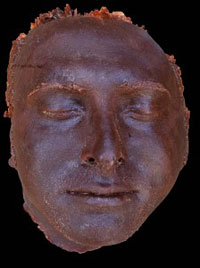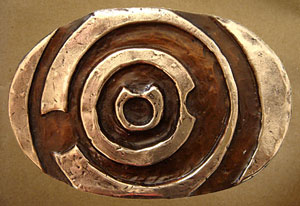A Sense of Eternity: The Bronze Work of Peter Harper
 Mary, bronze sculpture.
Mary, bronze sculpture. Photograph courtesy of Peter Harper
Let's assume you come from a family of artistically-inclined people. Let's say that you are the youngest brother to both Grammy Award-winning musician Ben Harper, and renowned writer Joel Harper, and that your parents and grandparents all exhibited a creative streak. Welcome to the world of bronze sculptor, Peter Harper.
"I grew up in a family where if you said you wanted to be a doctor, they looked at you funny," he says. "Painting, drawing, and sculpting were highly praised. Academics weren't disregarded, but the notion of taking a job simply to pursue financial security was outlandish. My family owned a music store/museum in Pomona, California, where there were instruments, painting, posters, and sculptures of folk art from all cultures and all walks of life," he says. In essence his after school time at the store was his "day care" as he calls it. He learned to repair the instruments, and started making small ceramic drums. "I had this propensity toward sculpture so I started making these crude and frankly terrible sculptures," he jokes. He still has some of them and occasionally pulls them out to remind himself that, although he had no formal art education in his formative school years, his artistic bent is really part of his DNA.
When it came time for college, Harper's penchant for political science, specifically the Third World, drew him to study abroad in Zimbabwe. Once the semester ended, he was slightly adrift, and didn't want to return to the U.S. just yet. He heard of the art school Mzilikazi Arts and Crafts Centre in Bulawayo and applied, and his journey into the arts began.
"I thought I'd be studying abstract, figurative work, but it was the exact opposite," he recalls.
The training was exceptionally formal with a focus on Grecian and Roman formulas, accurate proportions, and breaking everything down to scale. "The professor would pick up a ceramic face that I was working on and say it was beautiful. Then he'd take out a knife and cut off the eyes, ears and nose and say start again."
 Artist Peter Harper doing a bronze pour for Faces of Life.
Artist Peter Harper doing a bronze pour for Faces of Life. Photograph courtesy of Peter Harper
But through this process, he became a better student. He returned to the US and received his masters in fine arts from NYU which allowed Peter to hone his voice. He then went back to Pomona to learn mold making, and quickly fell in love with the medium of bronze after he began casting his work.
Soon after, Harper had his first exhibition at the Avatar Gallery in Pomona, and was impressed by the visitor's reactions. "The men had this macho reaction to bronze, they wanted to pick it up and hold it," he says. "The women's approach to bronze was the attraction to power, and they wanted to pet it." He still works with ceramics, even oil painting, but bronze resonates with him and his audience. "I'm not knocking other materials, but everybody understands that if you bump ceramic, it will break. You bump bronze, you break your toe."
Something about clay felt impermanent to Harper. "The reaction with bronze was this magnetism and I think it has to do with the idea of permanence of bronze, longevity," he ponders. "Bronze has a sense of eternity. There's an understanding that it will live beyond our existence and people sense that on some level."
His work sold quickly and though his first major show wasn't L.A or New York, it didn't matter. "I love what I make; if I don't love it I won't cast it because bronze has permanence."

Face Mold for Faces of Life.
Photograph courtesy of Peter Harper
Today, Harper uses the lost wax method almost exclusively. His sculptures, replete with raw and emotive subtexts, lean towards an interpretative style. His work also includes Ashanti gold-weights, smaller bronze works historically used in Africa as weights to measure gold. The weights themselves were small sculptures and Harper has created a series of the Ashanti pieces referencing animals typical of African folk art. "These are not hyper realistic, they're fun in the African tradition," he says. He also has cast a plethora of bronze belt buckles.
He creates and applies his own patinas, using books as basic recipes then, just like a musician, does riffs off them specific to the individual bronze piece. "I'm not scientific about it. If I use liver of sulfur as a base, I might add ferric for variations of brown, cupric for variations of green, maybe silver nitrate, but I don't get out the measuring spoon," he admits. Art is about feel to Harper and no one formula works. "When I make patinas for color density, I heat the bronze and I hit it with patina and it does that steamy, evaporative thing and you see what's been absorbed in the pores of the bronze and you know if you need to add more water or crystals. I like that organic approach." Harper does his own chasing and is always hands-on. To finish his work he'll choose one of three options; he'll clear coat it, wax it or leave the bronze in its natural state. His work is always on display at the Folk Music Center in Claremont, Center for the Arts in Pomona, and at Cal State Channel Islands where he currently teaches art, and art theory. Though he pulls his supplies from a wide diversity of suppliers, he returns to the same foundry---Hilario's Fine Arts in Ventura.
 Crop One Belt Buckle
Crop One Belt Buckle Photograph courtesy of Peter Harper
He's been collected by Meg Ryan, Danny DeVito, and one gentleman in particular, Rico Garcia, whom Harper calls, "the most supportive collector I have." It was Garcia who told Harper he'd buy whatever he made, thus enabling him to tackle another project. Faces of Life is art on a grand, and imitate, scale.
"This project came about because I had the money to dream bigger," he says. To date he's cast the faces of 237 people from all walks of life; the CEO of Siemens, an ex-con, the captain of the Los Angeles Police Department, a waiter at a restaurant. It is this sense of capturing the similarities and diversity present within all our faces that appealed to him most. "Growing up as a child your parents tell you not to talk to strangers, which is valuable because it keeps you safe. As an adult one of the most valuable things you can do is talk to strangers," he says. For Harper, too many artists get lost in their studio and are too removed from people. Faces of Life captures humanity, cast in bronze and Harper has spent time with all of them. A documentary and book will coincide in late 2011 or early 2012, supporting the traveling show. Harper envisions taking the show on the road, literally. He dreams about a big rig, a mobile art gallery, getting the bronze faces to places where there is little community access to art, and of returning art to the masses. His vision is to let everyday citizens glimpse their own image, knowing it will be there for eternity.
Resources:
Also in this Issue:
- A Sense of Eternity: The Bronze Work of Peter Harper
- Copper Sonja: Beautiful and Unusual Mixed Metal Jewelry
- Darby Patterson: Love in Bronze
- Deep in the Heart of Patridge
- New Copper and Glass Wing at UA Museum Focuses on Optical Sciences
